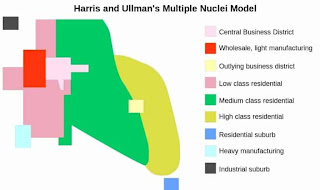Introduction
It is an economic model created by CD Harris and E.L Ulman in the 1945 article " The Nature of the Cities. This model was based on Concentric Zone Model and Sector Theory. It describes urban land use in which a city grows rom several independent points (nuclei) rather than from one Central Business District. Each point (nuclei) acts as a growth center for particular kind of land use such as industry, retail, port, university, etc. As this expand, they merge to form a single urban area.
1. Land is not flat in all areas.
2. Even distribution of resources.
3. Even distribution of people in residential areas.
4. Even transportation costs.
5. Profit maximization.
Zones:
a. Central Business District (CBD)
It exists as a primary nucleus but multiple small business districts developed and distributed around the metropolitan area.
b. Wholesale Light Manufacturing
Business are more consumer oriented and near residential areas. Manufacturing goods that need small amounts of raw materials and space develop in this area.
c. Low Class Residential
People who live here tend to be factory workers and live in low income housing.
d. Medium Class Residential
It is a bit more desirable because it is located further from industry and pollution. People who work in the CBD have access to good transportation lines making their commute easier.
e. High-Class Residential
It tend to be quite clean and have less traffic than the other ones.
f. Heavy Manufacturing
It is occupied by the factories that produce material that is heavy like chemicals, steel, etc
g. Outlying Business
It competes with the CBD for residents who live in nearby middle and high-class neighborhoods offering similar services and products as the CBD.
h. Outlying Residential Area
It is usually single family homes on a small plot of land on the outskirts of the city.
i. Industrial Area
It is community created an zoned for industrial sources on outskirts of the city.
Criticism:
- Negligence of the height of buildings.
- Non-existence of abrupt divisions between zones.
- Each zone displays a significant degree of internal heterogeneity and not homogeneity.
- Unawareness of inertia forces.
- No consideration of the influence of physical relief and government policy.
- The concepts may not apply to Asian cities with different cultural, economic and political backgrounds.





0 Reviews:
Post a Comment